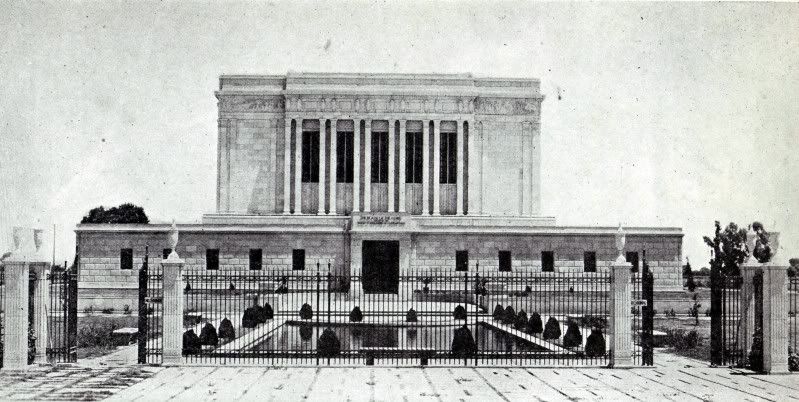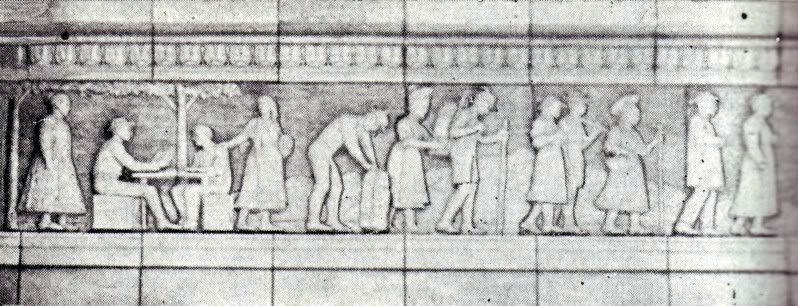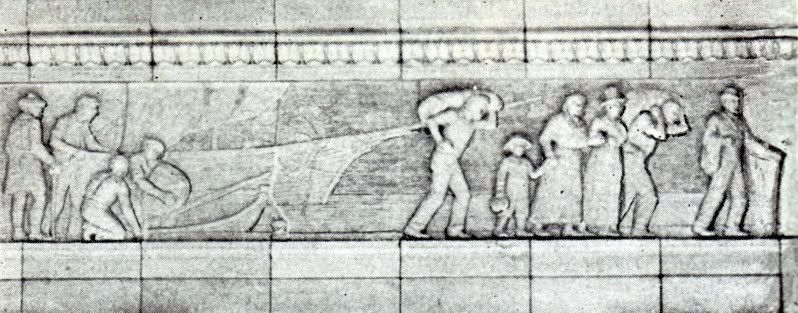 The first three temples of the 20th century (Laie Hawaii, dedicated 1919; Cardston Alberta, dedicated 1923; and Mesa Arizona, dedicated 1927) share an architecture that is radically different from the spired, crenelated pioneer temples of the 19th century. Joseph F. Smith is said to have described their boxy, spireless shape as resembling Solomon’s temple; others have compared them to Herod’s temple, or as reminiscent of Mesoamerican buildings. The architecture was also inspired by Frank Lloyd Wright’s Prairie Style architecture.
The first three temples of the 20th century (Laie Hawaii, dedicated 1919; Cardston Alberta, dedicated 1923; and Mesa Arizona, dedicated 1927) share an architecture that is radically different from the spired, crenelated pioneer temples of the 19th century. Joseph F. Smith is said to have described their boxy, spireless shape as resembling Solomon’s temple; others have compared them to Herod’s temple, or as reminiscent of Mesoamerican buildings. The architecture was also inspired by Frank Lloyd Wright’s Prairie Style architecture.
Although resembling each other somewhat – perhaps more in contrast to other temples than in actual resemblance to each other – each of these three temples has unique architectural details and decoration. This post pictures one of the unique features of the Mesa Arizona Temple, the frieze that runs around the building under its cornice, just above the columns and deep-set windows of the facade. (The frieze – pronounced freeze – is a ribbon of carved decoration. This picture, taken just after completion and long before the landscaping had matured, shows well both the stark, geometric temple architecture and the placement of the frieze – carved human figures on the sides and corners, with a geometric design across the front above the columns and windows.)
Alma Brockerman Wright (known chiefly for his highly colored paintings and murals) designed the frieze; Torleif S. Knaphus (who modeled the oxen supporting several temple baptismal fonts, and is the sculptor of the Hill Cumorah monument, the handcart memorial on Temple Square, and the Angel Moroni atop the Washington D.C. Temple, among many other LDS works) translated those sketches into the terra cotta panels that we see today.
I have not been able to find the dimensions of the frieze, although if the temple’s parapet is four feet deep, as one source noted, then the frieze appears to be about six feet deep, the figures somewhat larger than life size. [See UPDATE at end of post for reliable measurements, thanks to Jonathan Kland.]
The frieze represents a grand parade of converts leaving their old homes and gathering to Zion. This is not a generic line of generic people, however; the figures represent specific nationalities, and the artists even conceived mini-stories for some of them.

The four figures to the left are Italians. The woman and the seated man upon whose shoulder her hands rests are a husband and wife; the wife is a convert, the husband is not, and the wife is attempting to convince the husband to join her in gathering to Zion. To their right is a group of French peasants, on their way to Holland to board a ship to America. Those in the rear of the French group are wearing climbing clothes, having just descended from the Alps.

This group of European Saints has reached the port in Holland from which they will embark. A group of Dutch Saints carry their bundles aboard ship, while the Germans who have already boarded are stowing their belongings.

The emigrant ship has arrived in America. The figure at the rear is a Scotsman in kilt and tam o’shanter; Irish converts are gathering their belongings aboard ship; an Englishman leads a Welsh family off the ship and toward Zion.

The Saints have crossed the plains and almost reached their destination. The group of three in the lead represents Norwegians; a Swedish family follows them; a group of Danes brings up the rear.

On the other side of the temple, we see a group of American pioneers, including a couple pulling a handcart, who have just arrived in the mountains visible at the left of this picture.

A large number of Mexican Saints, the men identified by their sombreros and with some of their goods packed on a donkey, have left their Missions in the Southwest and approach the Lord’s House.

Another large group, this time of Indians, is also coming to the temple. The man toward the back with his arm outstretched is their chief who urges them onward; he is followed by another chief carrying a peace pipe.

This last group represents the Hawaiian Saints. Because they have their own temple in Hawaii by this time, these Saints are not traveling, but are pursuing the ordinary occupations of life. We see fishermen, two men pounding poi, and a woman playing the ukelele.
Just think – if Wright and Knaphus were to design a frieze for a temple today, how much larger the building would have to be to accommodate all the nationalities they would want to show coming to the House of the Lord!
UPDATE:
 Jonathan Kland (see comment 17) contributes this section image and calculates that the panel with the figures is about 3′ 8″ high, with 10″ precast pieces at top and bottom, giving the overall height of 7′ shown here. Ben Pratt (comment 14) has a good memory of the script he used to use when he recalls that as a guide he told visitors that the figures were about 4′ high.
Jonathan Kland (see comment 17) contributes this section image and calculates that the panel with the figures is about 3′ 8″ high, with 10″ precast pieces at top and bottom, giving the overall height of 7′ shown here. Ben Pratt (comment 14) has a good memory of the script he used to use when he recalls that as a guide he told visitors that the figures were about 4′ high.
Jonathan Kland, by the way, is an architect publishing one of my favorite new blogs, Salt Lake Architecture. Some of the buildings he features are modern, others historic, and I expect to link any posts that tie into Mormon history. Check it out.
Continue reading at the original source →



